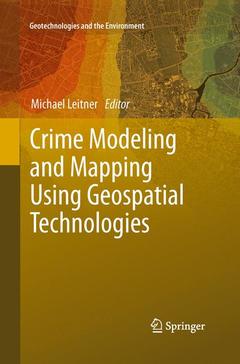Description
Crime Modeling and Mapping Using Geospatial Technologies, 2013
Geotechnologies and the Environment Series, Vol. 8
Coordinator: Leitner Michael
Language: English
Subjects for Crime Modeling and Mapping Using Geospatial Technologies:
Crime Modeling and Mapping Using Geospatial Technologies
Publication date: 06-2015
Support: Print on demand
Publication date: 06-2015
Support: Print on demand
Crime modeling and mapping using geospatial technologies
Publication date: 01-2013
446 p. · 15.5x23.5 cm · Paperback
Publication date: 01-2013
446 p. · 15.5x23.5 cm · Paperback
Description
/li>Contents
/li>Biography
/li>Comment
/li>
Recent years in North America have seen a rapid development in the area of crime analysis and mapping using Geographic Information Systems (GIS) technology.
In 1996, the US National Institute of Justice (NIJ) established the crime mapping research center (CMRC), to promote research, evaluation, development, and dissemination of GIS technology. The long-term goal is to develop a fully functional Crime Analysis System (CAS) with standardized data collection and reporting mechanisms, tools for spatial and temporal analysis, visualization of data and much more. Among the drawbacks of current crime analysis systems is their lack of tools for spatial analysis.
For this reason, spatial analysts should research which current analysis techniques (or variations of such techniques) that have been already successfully applied to other areas (e.g., epidemiology, location-allocation analysis, etc.) can also be employed to the spatial analysis of crime data. This book presents a few of those cases.
In 1996, the US National Institute of Justice (NIJ) established the crime mapping research center (CMRC), to promote research, evaluation, development, and dissemination of GIS technology. The long-term goal is to develop a fully functional Crime Analysis System (CAS) with standardized data collection and reporting mechanisms, tools for spatial and temporal analysis, visualization of data and much more. Among the drawbacks of current crime analysis systems is their lack of tools for spatial analysis.
For this reason, spatial analysts should research which current analysis techniques (or variations of such techniques) that have been already successfully applied to other areas (e.g., epidemiology, location-allocation analysis, etc.) can also be employed to the spatial analysis of crime data. This book presents a few of those cases.
From the Contents: Spatial Heterogeneity in Crime Analysis.- When Does a Drug Market Become a Drug Market? Finding the Boundaries of Illicit Event Concentrations.- Convicted Sex Offender Residential Movements.- Street-Level Spatiotemporal Crime Analysis: Examples from Bronx County, NY (2006–2010).- Exploring Spatial Patterns of Crime Using Non-Hierarchical Cluster Analysis.- Reconstitution of the Journeys to Crime and Location of their Origin in the Context of a Crime Series. A Raster Solution for a Real Case Study.- Journey-to-Crime by Gender and Age Group in Manchester, England.- Crime Scene Locations in Criminal Homicides: A Spatial Crime Analysis in a GIS Environment.
Michael Leitner is a Professor at the Department of Geography and Anthropology at the Louisiana State University in Baton Rouge (USA).
At LSU, he is teaching courses in (advanced) computer cartography, GIS, methods of spatial analysis, aerial photo interpretation, and how GPS collected data can be used for the analysis, modeling, and visualization in a GIS environment.
His current research interests include automated map generalization, the visualization of data quality and its effect on spatial decision support, the utilization of GPS for computer mapping, GIS, and spatial analysis, and the development of new techniques (for example, spatial association) for the spatial analysis of crime data. His research has been published in refereed journals and proceedings and has been presented at (inter)national conferences.
He also works for the Center of Geoinformatics at the University of Salzburg, Austria.
At LSU, he is teaching courses in (advanced) computer cartography, GIS, methods of spatial analysis, aerial photo interpretation, and how GPS collected data can be used for the analysis, modeling, and visualization in a GIS environment.
His current research interests include automated map generalization, the visualization of data quality and its effect on spatial decision support, the utilization of GPS for computer mapping, GIS, and spatial analysis, and the development of new techniques (for example, spatial association) for the spatial analysis of crime data. His research has been published in refereed journals and proceedings and has been presented at (inter)national conferences.
He also works for the Center of Geoinformatics at the University of Salzburg, Austria.
Poses interesting questions on crime in a geospatial context
Tackles various sorts of crime and places them in a geospatial context
Discusses a few applications and implementations of GIS
Includes supplementary material: sn.pub/extras
© 2024 LAVOISIER S.A.S.
These books may interest you

Advances in Spatial Data Handling and GIS14th International Symposium on Spatial Data Handling 158.24 €



